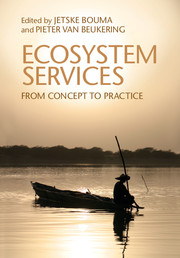Book contents
- Frontmatter
- Contents
- About the authors
- Part I Introduction
- Part II Measuring ecosystem services
- Part III Valuing ecosystem services
- Part IV Paying for ecosystem services
- 8 Market-based instruments for ecosystem services
- 9 Payments for ecosystem services
- Part V Governing ecosystem services
- Index
- Plate section
- References
8 - Market-based instruments for ecosystem services
from Part IV - Paying for ecosystem services
Published online by Cambridge University Press: 05 February 2015
- Frontmatter
- Contents
- About the authors
- Part I Introduction
- Part II Measuring ecosystem services
- Part III Valuing ecosystem services
- Part IV Paying for ecosystem services
- 8 Market-based instruments for ecosystem services
- 9 Payments for ecosystem services
- Part V Governing ecosystem services
- Index
- Plate section
- References
Summary
Introduction
The concept of ecosystem services is useful but also rather controversial. In part, this controversy relates to what is sometimes called the “commoditization” of ecosystem services (Muradian and Rival, 2012; see also the introduction of this book). Many people feel that the benefits that nature provides us with should not be conceptualized as “services” comparable to those supplied by traditional markets (e.g. the legal services of a lawyer or the financial services of a bank).
Nevertheless, many environmental economists have observed that market mechanisms can play an important role in balancing the “supply” and “demand” of ecosystem services. For example, farmers respond to subsidy schemes that offer them a fair reward for environment-friendly practices and consumers with “green” preferences tend to buy ecolabeled products.
Unlike actors in traditional markets, the suppliers and consumers of ecosystem services often do not directly engage in transactions with each other. This has to do with four typical and closely related features of many ecosystem services (also known as “market failures”):
Their “public good” (or “collective good”) nature: Ecosystem services, such as those provided by pristine forests and clean rivers, are there for everyone to enjoy. No one can be excluded from the tangible and intangible benefits they provide and (to a certain extent) there is no rivalry in their use (that means that their enjoyment by any individual does not preclude the simultaneous enjoyment by others).
- Type
- Chapter
- Information
- Ecosystem ServicesFrom Concept to Practice, pp. 163 - 182Publisher: Cambridge University PressPrint publication year: 2015



